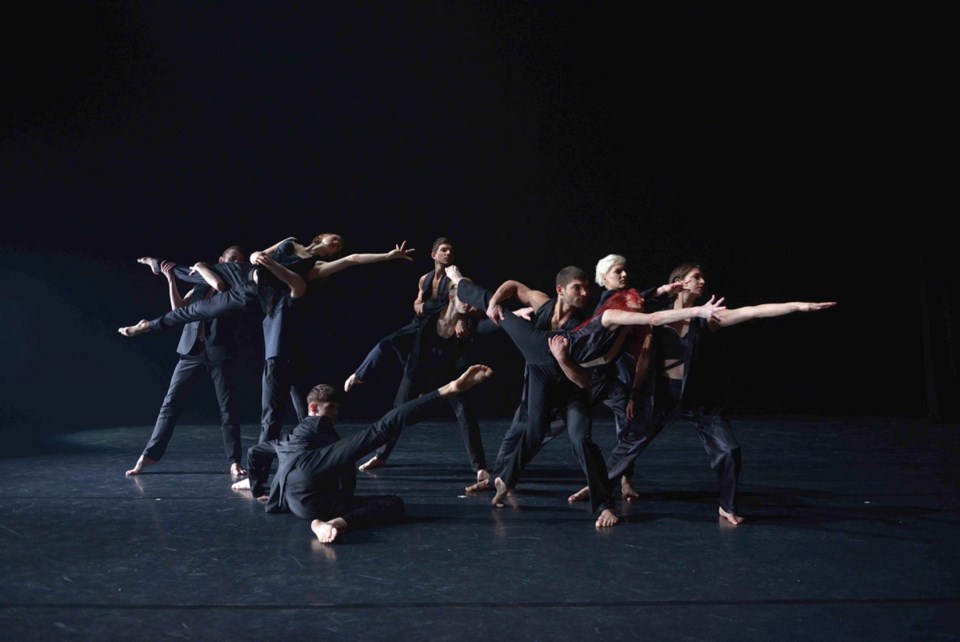REVIEW
Les Ballets Jazz de Montreal
Where: Royal Theatre
When: Feb. 26
Rating: four (out of five)
One can’t help but admire Les Ballets Jazz de Montréal. The dance troupe roared into Victoria this weekend with enough energy to power a mid-sized city.
Les Ballets Jazz offered a trio of markedly different dances. The unifying factor was a take-no-prisoners vitality, a sense all 13 dancers were absolutely committed to a program that doubtlessly left them physically drained each night.
The most satisfying offering was Kosmos, a full-length work by Greek choreographer Andonis Foniadakis. The dance is inspired by the rhythms of big cities, the energy of crowds and traffic.
Kosmos started boldly, no music at first, with the ensemble (dressed in black) seemingly locked in the grip of invisible rhythms. One could hear sounds of flesh on flesh, slapping and clapping.
The score, by Julien Tarride, is often percussive and relentless. Occasionally, there are portentous voice-over utterances such as: “This is only the beginning.” The movement was typically sinuous, intertwined, marked by bold leaps. Very vigorous, very athletic.
The overriding sense in Kosmos is that of humanity thrust into an industrial environment. The two are not always at odds; Foniadakis suggests there’s poetry within the struggle. The performers would move in a manner suggestive of an agitated, deeply personal world; elsewhere the dance suggested the tyranny imposed by human-made machines with which we co-exist: automobiles, subways and so forth.
In the middle there’s an interlude. The dancers (one could hear them panting Friday night) gathered in the centre of the stage, striking sculptural poses. A beautiful pas de deux, supported by stately string music, followed.
What came next was truly remarkable. The ensemble appeared on a dark stage illuminated only by a curious dabbled light. The effect was like being underwater (the dance’s title suggests it’s more likely the cosmos). The movement was calmer than the first section, almost a tableau. It was an astonishing scene; afterwards, the audience erupted in cheers.
Equally impressive was a shorter pas de deux, Mono Lisa, choreographed by Itzik Galili and beautifully danced by Celine Cassone and Mark Francis Caserta. It’s set to the sounds of an old manual typewriter — peckings, swishes, scratching and an occasional ring. This was more than mere sounds, the music had its own funky groove.
Danced under two rows of lowered spotlights, Mono Lisa started as a battle of the sexes. Each dancer (costumed simply in rust and burgundy) performed a solo turn capped by a “how about that?” expression. The work, more conventionally balletic in its vocabulary, soon evolved into a jaw-dropping showcase. Although the dancers were often sensually intertwined, Mono Lisa was remarkable for its athleticism. Particulary notable were its technically challenging lifts. Several times Cassone, held aloft, splayed her straightened legs horizontal to the stage (a sort of human coat-hanger shape), eliciting a “Wow!” from the crowd. This short, invigorating work left us wanting more.
The evening opened with Rouge. This dance, for full company, is by Rodrigo Pederneiras of Brazil’s famed Grupo Corpo troupe. Rouge is loosely inspired by First Nation peoples of America and South America.
The music, by The Grandbrothers, employs a variety of nature sounds. The dance commences with Amerindian-style howls, set against cellos (or violins). We also hear running water, the cries of wolves and geese. There’s no attempt to create an “authentic” traditional score though — electric guitar power-chords can be heard at times.
One of Pederneiras’ aims is to conjure the primal excitement of aboriginal ritual. The female performers wore dresses with geometric, Aztec-style patterns (these are a matter of taste, they brought to my mind those “cowboy-and-Indian” movies of the 1960s). The movement was intriguing — typically, the dancers moved like disjointed dolls, heads snapping. There was a suggestion of conflict at times, bringing to mind warring tribes. More often, the choreography created a sense of ecstatic, even trance-like ceremonial dance, with an emphasis on lower body movement.
There were many fine sequences, including some wonderful pas de deux. Yet there’s a certain literalism at work here, in the music, the costumes, the red (rouge) lighting, the repeated copulatory pairings (yes, we got the message). The pounding music, which was very loud, threatened to overshadow what was happening on stage. Unison dance sequences sometimes lacked precision. This, no doubt is intentional. Yet sometimes, the overall effect was of aimless athleticism.
Still, overall, this was a worthwhile — and at times exhilarating — evening of contemporary dance.



